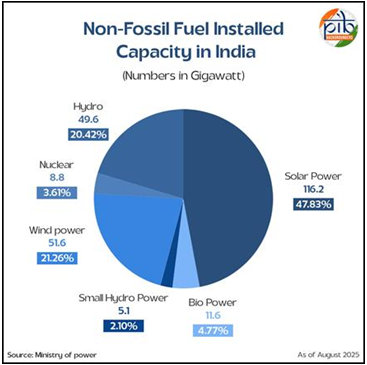

20th August 2025 (20 Topics)
Context:
India surpassed its COP26 commitment, achieving over 50% non-fossil fuel installed power capacity five years ahead of the 2030 target.
India’s Fast-Track Green Transition and Renewable Energy Leadership
Surpassing Renewable Targets
- India achieved 50.07% of installed power capacity from non-fossil fuels (242.8GW out of 484.82GW) by June 2025, surpassing the COP26 target five years early.
Global Renewable Rankings
- 4th in Renewable Energy Installed Capacity
- 4th in Wind Power Capacity
- 3rd in Solar Power Capacity (IRENA, 2025)
Solar Power Output
- India produced 1,08,494GWh of solar energy in 2025, overtaking Japan to become the third-largest solar power producer.
Expansion of Solar and Renewables
- Solar Capacity Growth
- Total solar capacity:02GW (as of July 2025); marked by a 4,000% increase in the last decade.
- Composition:99GW (ground?mounted), 19.88GW (rooftop), 3.06GW (hybrid), 5.09GW (off?grid).
- Geographic Potential
- India's solar potential: 748GW; high-potential states include Rajasthan, J&K, Maharashtra, Madhya Pradesh, Andhra Pradesh, and Gujarat.
- Record Surge in Installation
- Renewable energy installed capacity:99GW in 2025, up from 76.37GW in 2014.
Manufacturing and Domestic Industry Boost
- Solar Manufacturing Capacities
- Module manufacturing grew from 38GW (March 2024) to 74GW (March 2025).
- PV cell manufacturing rose from 9GW to 25GW in the same period.
- Ingot-wafer manufacturing initiated (2GW).
- Policy Support
- Mandatory Indian-made panels for government-backed projects
- Basic Customs Duty (BCD) on imports since April 2022 to incentivize local manufacturing.
Flagship Schemes & Policy Initiatives
- PM Surya Ghar: Muft Bijli Yojana
- Budget: ?75,021 crore; targets 1 crore households with up to 300 units/month free electricity through rooftop solar installation.
- PM-KUSUM
- Subsidies (30-50%) for farmers installing solar pumps; support for decentralized solar plants up to 2MW; builds farmer energy security and additional income.
- Solar Parks Scheme
- Target:40GW by March 2026.
- Progress: 53 parks (39,323MW approved, 13,896MW operational in 26 parks).
- PM JANMAN: Tribal Electrification
- ?515 crore allocated to electrify 1 lakh un-electrified households in PVTG areas across 18 states.
- Floating Solar Projects and Agrivoltaics
- Projects such as Omkareshwar Floating Solar Park and agrivoltaics demonstration sites exhibit innovation in land and water use.
Green Hydrogen and Alternative Energies
- National Green Hydrogen Mission
- By 2030:5 million tonnes annual production, ?8 lakh crore investment, 6 lakh jobs, significant fossil-fuel import reductions.
- International Collaboration

- International Solar Alliance (ISA) and One Sun One World One Grid (OSOWOG): multilateral efforts to enhance global solar connectivity and technology sharing.
Renewable Sector: Current Overview and Additional Contributions
- Ethanol Blending
- Ethanol blending in petrol reached 17.98% by Feb 2025; target of 20% by 2025–26.
Policy Roadmap and Future Outlook
- Government Priorities for 2030 Targets
- Long-term Contracts: Investor confidence
- Grid Strengthening: Smart grids, storage
- Make in India: Further localization of supply chains
- Smart Land Use: Floating and farm-based solar
- Easy Financing:Enabling capital flow for RE projects
- Green Jobs and Economy
- Job creation and investment—solar and green hydrogen sectors highlighted for potential to generate millions of jobs by 2030.
- Net Zero by 2070
- India remains committed to achieving net-zero emissions by 2070, with a 45% reduction in carbon intensity by 2030 (over 2005 levels) in line with its Paris Agreement NDC.
Challenges Ahead:
- Energy Storage:Need for rapid scaling of energy storage to ensure grid stability as RE share rises
- Manufacturing Ecosystem:Upgradation in solar PV technology, expanded supply chains
- Skilling and R&D:Address skilled workforce requirements for new technologies (incl. hydrogen, storage)
- Financing:Mobilisation of low-cost, large-scale finance for both grid and off-grid RE
Way Forward:
- Accelerate deployment of grid-scale storage and advanced forecasting systems
- Strengthen policies for domestic R&D in RE and hydrogen
- Expand mini-grid and decentralized renewable systems for last-mile access
- Maintain policy certainty and invest in capacity building for implementing agencies
- Explore regional and cross-border RE trade through platforms such as ISA and OSOWOG

